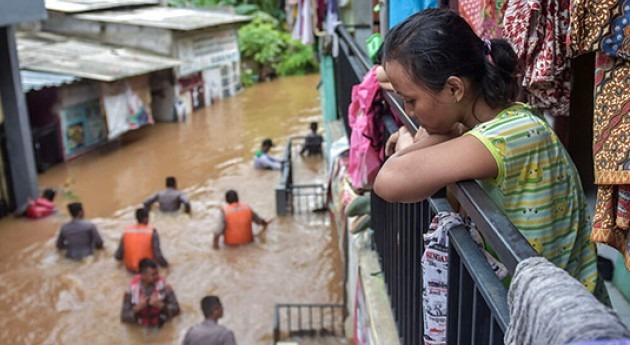The population of Jakarta has a lot to put up with. Virtually every year, parts of the city are subjected to heavy flooding. But this year the city experienced the heaviest monsoon rains for many years – and they arrived on New Year’s Day. More than 60 people died in the floods and in landslides precipitated by the torrential downpours, while some 400,000 inhabitants of the city and its metropolitan area were forced to take refuge in emergency shelters. Moreover, meteorologists hold out little hope that the situation will improve any time soon. The rains continue and may actually get worse as the season advances.
Climate change has dramatically increased the risks of natural disasters in many regions of the world. The risk of extreme events has increased significantly: Cyclones, floods, but also droughts or heat waves – the statistics show a clear increase in their frequency and destructive power. Modelling also suggests that this trend will continue and in some cases even accelerate with climate change.
Matthias Garschagen analyses what makes storms, floods and heat waves particularly devastating. However, he does not only look for the physical causes of the destructive power, but above all for the political, economic, social and cultural reasons that make an urban society or even individual population groups vulnerable. Vulnerability – this is the term that has become established to grasp the susceptibility of societies to the natural hazards mentioned. Above all, however, the geographer also examines the possibilities cities have for adaptation, in order to keep the effects of such extreme events as small as possible.
Environment and human security: Garschagen's work has provided him with a wealth of experience in some regions of the world
He originally comes from disaster studies, says Garschagen about his professional biography. Over the years, however, his research has increasingly focused on how cities can adapt to the consequences of climate change, so to speak in response to current events. For several years he headed a research section at the United Nations University (UNU), the "academic arm" of the United Nations. It maintains the Institute for Environment and Human Security in Bonn. Since spring 2019 he has held the chair of human geography at the LMU with a focus on human-environment relations. He is also a lead author within the Intergovernmental Panel on Climate Change (IPCC).
Where the wealthy don't want to live
For Garschagen, Mozambique is a good example of how the poor half of humanity bears a "double burden" of inequality – through global development disparities and the unequally distributed risks of climate change. In March 2019 the Cyclone Idai raged over Mozambique for just a few hours. The storm was a disaster for the country and its people. About 1,000 people died, three million needed disaster assistance afterwards. But after this first blow only a month later, the second followed: Kenneth, another severe cyclone, devastated the country. And it has not yet been determined whether and how quickly Mozambique will recover from the 2019 storm season.
Even the rough figures indicate that the country is one of the poorest in the world. Almost two thirds of the population live on less than 1.90 dollars a day, wrote Garschagen and his colleague Mark Pelling from King's College London in a detailed commentary in the renowned scientific journal Nature. Mozambique is at the bottom of the UN development index: 180th out of 189 countries. At the same time, however, the state is one of the three countries in Africa most severely threatened by climate change.
Climate change has dramatically increased the risks of natural disasters in many regions of the world
But even that is only part of the reality, argues Garschagen. Such average figures give a distorted picture of how hard it can hit individual population groups. Within cities, for example, the poorest of the poor often live in locations with the highest exposure to flood hazards, such as on river banks - where more affluent sections of the population do not wish to settle. At the same time, the poorest have the least capacity to cope with extreme events. For Nigeria, for example, scientists have quantified the effects of this unequally distributed risk. The poorest 20 percent of the population are 50 percent more likely to lose their lives, livelihoods or health in the event of a flood than the average person in Nigeria. The differences in the risk of being particularly affected by a drought or heat wave are even more pronounced.
Environment and human security: Garschagen's work has provided him with a wealth of experience in some regions of the world, especially in countries where emerging economies are generating particularly strong pressure to change. This autumn, the geographer from Munich is back in Vietnam. Garschagen knows the socialist state with the tight one-party system well, he has spent a long time there. Vietnam is one of the countries that will presumably have to struggle particularly hard with climate change. Its main urban agglomeration Ho Chi Minh City is already recording a noticeable increase in flood events. The trend so far has been driven mainly by strong urban growth and inadequate sewerage systems, but it allows a glimpse into the future, when sea levels will rise and an increase in heavy precipitation will further exacerbate the problem. Cities in central Vietnam such as Hue or Da Nang are also affected by hurricanes, the intensity of which is increasing. So what do future risk trends look like, especially in such dynamic societies whose economic and social development is so difficult to predict? And what is the impact of climate change?
When will economic livelihoods be destroyed?
Will these cities collapse at some point? "The cities as such will not. Even Vietnam as a state is now wealthy enough to deal with some adversity." More important for Garschagen is another question: How long can the poorest ten percent of the population deal with the increasing stress from hazards? When will their economic livelihoods be destroyed? Can the small entrepreneur still recover economically when the storms of last year's season have destroyed his truck and his warehouse? "It is such questions about the limits of adaptation that are currently driving us at the IPCC. And this is about the weakest in society and not about the average," Garschagen emphasizes.
The problems in the Indonesian capital Jakarta are even bigger - and the supposed solution is even bigger
However, risk management is often far removed from social justice. Garschagen has a few examples of this. During the devastating floods in Bangkok in 2011, for example, the authorities allowed the surrounding poorer districts “to fill up” in order to protect the government and palace districts in the city center from flooding, he reports. In Calcutta, urban planners and investors have made a large inner-city area, the Salt Lake District, largely flood-proof. They have elevated the land, installed pumps and drainage systems – a massive effort for flood protection. Today the area is inhabited by a wealthy population. However, informal settlements of those who provide services for the rich are growing in the surrounding areas. These people live with an even higher risk because the water that is pumped off in the protected areas also runs up there. Such prestige projects miss a solution because they ignore the question of social vulnerability, comments Garschagen.
The problems in the Indonesian capital Jakarta are even bigger - and the supposed solution is even bigger. The ten-million strong metropolis is subsiding; in the districts most affected, the ground is sinking between five and ten centimeters per year, a breathtaking speed. This is mainly due to illegal groundwater extraction. Already today, many quarters are below sea level, some more than a meter; temporary concrete walls are intended to protect them from flooding. Experts estimate that 80 percent of the urban area could be affected by 2030.
A huge dam in front of Jakarta
A gigantic construction project has been underway for years: a huge dam is to seal off the bay of Jakarta. Huge pumps, according to the concept, will create a basin for its protection and regulate the water levels of the 20 rivers that cross the city. Private investors will develop luxury properties along the coastline in order to refinance this expensive mega-project. Much of the current coastal population is to be resettled; the already strong pressure of urbanization will possibly drive them to highly exposed locations.
For Garschagen, this raises the scientific question of whether large-scale solutions such as these can bring about a "transformation" of risk management, a kind of liberation blow that takes it to another level. In a study he and his colleagues from Bonn evaluated the available data in the Jakarta case. The researchers' verdict is sobering: "The strategy cements the common paradigm of risk management rather than transforming it – the principle of controlling the effects of the tide rather than tackling the man-made causes." In addition, the ecological and social costs are high and the long-term benefits controversial.
Private investors will develop luxury properties along the coastline in order to refinance this expensive mega-project
For Garschagen, the example of Jakarta clearly shows that the decisive question is no longer whether adaptation to climate change is technically and financially feasible. "The instruments for this are known. Political and institutional issues pose the greatest challenge: How do we get the whole thing on track fairly?" In Jakarta Garschagen has just launched a new project to explore future risk trends and adaptation options. The question of what the future holds for the social vulnerability of urban society depends to a large extent on global economic questions: How are trans-Pacific trade and international trade agreements developing? Which decisions today make the adaptation strategy fit for the future, make it robust against future risk developments and at the same time readjustable? And last but not least: How can stakeholders' participation in decision-making be ensured?
Garschagen's team works with a mixture of classical methods of empirical social research and more recent scenario techniques. The scientists interview decision-makers, key actors from civil society, the affected population, representatives of businesses. They carry out big household surveys to get a picture of the status quo. What about social vulnerability? How do those affected deal with risks? How high, for example, is the willingness to take out insurance? Using innovative scenario techniques and models, the scientists then aim to map possible future paths, considering future urban development and forms of social decision-making.
Half a billion more people
In recent years, for the first time in human history, more than half of the world's population lived in cities, and the trend continues to rise sharply. Towards the middle of the 21st century, the proportion may already be two-thirds. And whenever it came to urban growth dynamics, including the risks and downsides of unchecked urbanization, the megacities, the huge agglomerations whose sheer size soon overshadowed many capitals of the Western world, were the measure of all things. But even faster, as Garschagen and colleagues from Germany, the USA and Uganda wrote in a further article in Nature, small and medium-sized towns are growing, although the term may seem relative from a European point of view: it describes town sizes from 300,000 to five million inhabitants. For the years between 2015 and 2030 alone, experts expect growth of more than 30 percent there. Globally, this would correspond to an additional half a billion inhabitants. According to these estimates, the megacities on the globe will "only" grow by a combined 200 million.
In recent years, for the first time in human history, more than half of the world's population lived in cities, and the trend continues to rise sharply
And as far as the risks of natural disasters are concerned, the pace of population growth is more decisive than the size of the city, argues Garschagen. "This has long been misjudged. In fact, small and medium-sized cities with high growth dynamics often have a particularly low adaptive capacity. They are particularly vulnerable." Technical expertise, resources, tax revenues, private capital, political attention – anything that can help municipalities prevent or deal with disaster is more likely to be found in the big cities than in the small ones. There, the uncontrolled growth may quickly lead to the city administration surrendering. "The cities are growing so fast that economic development cannot keep pace. They don't even have the added value to operate infrastructure sensibly." Such a decoupling of urbanization and economic growth can be observed above all in African states.
But even in the so-called First World, in affluent countries such as Germany, where social security systems compensate comparatively well, as Garschagen points out, there is social vulnerability as far as the effects of climate phenomena are concerned. "In Munich, for example, there are many who are affected by poverty in old age. You don't always see it that way when you're walking around hip Maxvorstadt." Often these are single people, who may live socially isolated and immobile in narrow, poorly air-conditioned apartments. What risk do these people run if, as in the past two summers, heat waves become even more frequent and intense in the future?
Together with partners, Garschagen is currently investigating such questions in the two case study cities of Ludwigsburg and Bonn, financed by the Federal Ministry of Education and Research. "We start by trying to understand how the risk is distributed in the first place, try to identify those who would be particularly affected by a heat wave. We also work together with rescue services and institutions providing care. We have also carried out empirical surveys: Do the city dwellers still know who might be in need in their neighborhood?” Cologne and Kerpen are the case studies in another research project. This is about the failure of critical infrastructures: What happens if the drinking water supply is endangered due to a power failure? "Do we even know," asks Garschagen, "what orders of magnitude of minimum care we have to think about?"
What are the limits of adaptation?
Providing sound, "well evaluated" decision bases is one of his tasks as a scientist. In September, the Intergovernmental Panel on Climate Change has published the Special Report on the Ocean and Cryosphere in a Changing Climate (SROCC), in which the Munich geographer has been a leading author. What actually happens to the globe and the people on it - that is what the report is concerned with - when, for example, the polar caps melt and the soils in the permafrost regions thaw? What are the possibilities of adaptation? What are their limits? When are the only options left to live with losses and destruction? The IPCC has the "golden rule", says Garschagen, to be policy relevant but not policy prescriptive, providing decision makers with the best available scientific knowledge, but to point out the consequences of different development paths. "Science is an important voice in the climate debate. But in the end, it is a governance process in which society as such must negotiate which way it wants to go."
Of course, this does not mean that the findings of the scientists should not be seen as a reminder. In any case, the IPCC's previous special report a few months ago anticipated one thing. To this end, the scientists investigated the conditions under which global warming could still be kept below 1.5 degrees Celsius. "The report has shown," says Garschagen, "how late it is for us to tackle climate change now."





